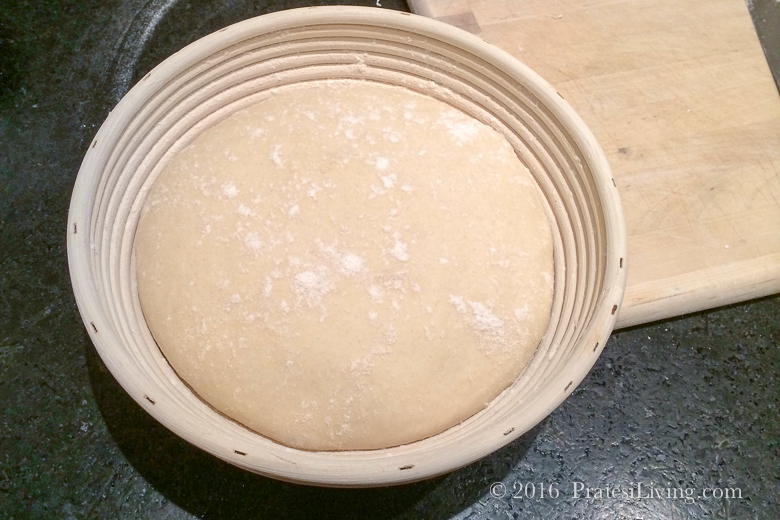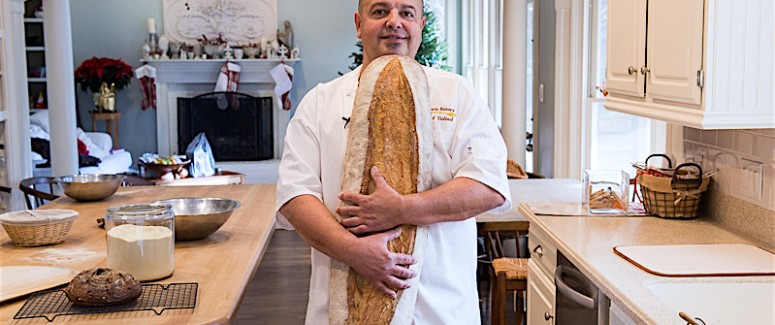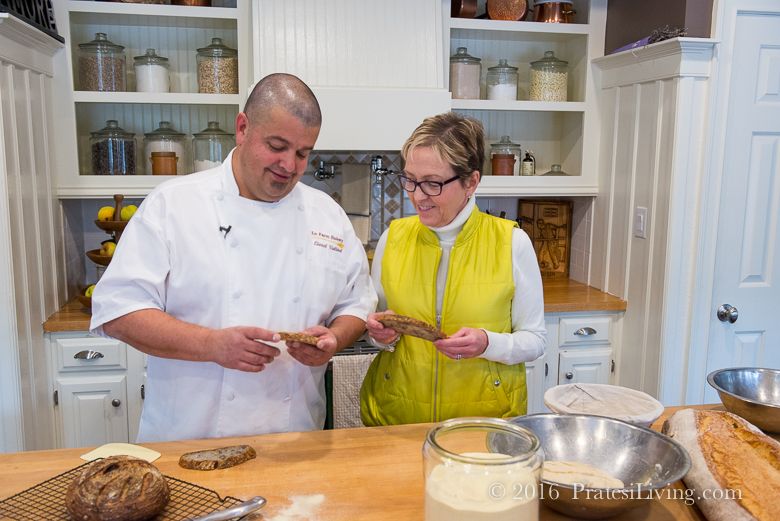Techniques for Baking Bread from Master French Baker Lionel Vatinet
A Passion for Bread
Bread is one of our passions. When we travel to France, Italy (and recently Ireland), bread tasting is as much a part of our focus as wine and food. We’ve been known to stop at each boulangerie or bakery we see and buy bread, picking a winner from each town or trip. Our tasting notes include color, taste, texture, saltiness, consistency, and freshness. It’s rare to find bread in the States that compares. We always thought it was the water or the flours from the local regions in Europe that produced the taste and quality that wowed us or very likely, it could be that our surroundings had as much to do with the taste and texture as the ingredients. However, as we’ve discovered, it’s very much about mastering the art of bread making.
Lionel Vatinet – La Farm Bakery, Cary, North Carolina
It was four years ago that we first met Lionel Vatinet, a Master French Baker from France. Lionel is the owner of La Farm Bakery in Cary, North Carolina, a small town near Raleigh. He is a semi-finalist for the 2016 James Beard Awards (his second time) for Outstanding Baker. When we first met, we were at a food and wine festival and he was providing samples of his bread to eager tasters in the food tent. We were impressed with the beauty of his presentation; the color, the textures, the incredible shapes, and varieties of breads drew us to his table. We didn’t expect it would compare to the breads we tasted in Europe, as we have been disappointed again and again when purchasing artisan breads in the U.S., but we were wrong. This bread was similar to the breads we’d tasted from the finest bakeries in France. How was he achieving it?

Some of the many breads at La Farm Bakery

They also bake many seasonal specialties such as Stollen and other holiday favorites

They also make French pastries, croissants, and cakes
Over the years we became friends with Lionel. A Frenchman with an attitude, if you can believe that; but his attitude is one of humor. Gwen became fascinated with the techniques he learned as a Master French Baker after reading his book, A Passion for Bread. Then she took a bread baking class from Lionel to learn some of his secrets and to her surprise, the secret ingredient was not an ingredient at all. Sure, he uses high quality local flours and a particular yeast, but he isn’t shipping in flour from France or water from New York (referring to the mystique of the New York bagel). It is mostly about technique. It’s how you treat the ingredients and how they are integrated. It’s how you work with the gluten, the fermenting (or proofing) process, making sure the dough is the right temperature, and then properly baking the bread that creates the unique texture and taste, that up until years ago, we had only found in France.

A Passion for Bread – A Bible for French bread baking
With the knowledge of the tools and techniques from his book and the baking class, we started baking bread at home. We bought the right ingredients. We already owned or invested in the right tools: a cloche, a banneton (proofing basket), instant-read thermometer, a baker’s knife, and dough scraper. Our tools in conjunction with Lionel’s technique allow us to produce some of the finest bread that we have eaten. Other friends that became interested in baking bread with his methods have also said it’s the best bread they’ve ever had.

Banneton

The Boule I baked from the dough prepared at Lionel’s class
Baking Bread with a Master French Baker
With that in mind we asked Lionel to share his bread making technique with our readers. The following video shows the techniques to produce a Fig, Polenta, and Walnut Sourdough Bread, but the technique to work with the wet dough is the same for many of his breads. One of the keys is to not add flour when working with the dough. Doing that offsets the balance with the recipe and it’s this “wet” dough and how it’s handled that creates the unique texture with the proper density and perfect crust. The first part was filmed at La Farm Bakery and we finished in Lionel’s kitchen at home since he wanted to show the method a home cook would use when baking bread in a regular oven.

A boules, Bâtard, and Pain D’Epi – Only use flour to dust the surface after the bread is fermented
In addition to making traditional French breads, Lionel works closely with local artisans, grain growers, and millers such as Anson Mills in Columbia, South Carolina and Carolina Ground in Asheville, North Carolina to create unique artisan breads made with these specialty ingredients, such as his Fig, Polenta, and Walnut Sourdough Bread

Fig, Polenta, and Walnut Sourdough Bread
There’s something very satisfying about bread baking and creating a beautiful crusty loaf of bread at home. The aroma fills your house and the taste is incomparable to the breads you purchase at the grocery store. Bread baking is an art that takes practice and patience, but so well worth the learning curve. Lionel has shared a detailed recipe below for the bread he made in the video, Fig, Polenta, and Walnut Sourdough Bread. Here is another recipe from Lionel’s book, A Passion for Bread, Honey Whole-Wheat Bread.

Fig, Polenta, and Walnut Sourdough Bread
Ingredients:
- 11.25 ounces, 315 grams (2 1/2 cups) unbleached, unbromated bread flour
- 2.25 ounces, 65 grams (1/2 cup) whole wheat flour
- .31 ounces, 9 grams (1 1/2 teaspoons) fine sea salt
- 9.88 ounces, 280 grams (1 1/4 cups) water
- 3.5 ounces, 100 grams (1/2 cup) Liquid Levain (natural sourdough)
- 2 ounces, 56 grams (1/2 cup) toasted walnut pieces
- 2.75 ounces, 80 grams (1/2 cup) chopped figs
- 2.75 ounces, 80 grams (1/2 cup) cooked Anson Mills Course Rustic Polenta Integrale
- Cornmeal for dusting the peel
Directions:
Step 1: Measuring and Preparing Polenta
For Polenta
- Boil 1 cup of water in small saucepan and add polenta. Stir for 7 minutes until the water is gone. Spread polenta on a sheet pan lined with parchment paper and refrigerate.
- Organize your ingredients. You will need 5 separate bowls; a medium mixing bowl for the dry ingredients, 2 smaller bowls for the liquid, the bowl of the standing electric mixer, and a large glass or metal bowl for the first fermentation.
Step 2: Mixing and Kneading by Stand Mixer
- Place the white and whole wheat flours and salt into a mixing bowl, stirring to blend well.
- In a separate bowl, combine half of the (65°F to 70°F) water, tare the scale, and then add the Liquid Levain (natural sourdough), stirring to blend. This insures that the levain does not stick to the sides of the measuring vessel.
- In another small bowl, scale the remaining water.
- Pour the levain-water mixture into the bowl of the standing electric mixer. Add the flour-and-salt mixture. Then, attach the dough hook to the mixer. Begin mixing on low (1 on most mixers) and continue to mix until the dough becomes soft and moist. Mix for 5 minutes, frequently stopping the mixer and scraping down the sides of the bowl with a bowl scraper (or rubber spatula) to make sure that all of the ingredients are incorporated into the dough.
- Taste the dough. This is a simple way to check if you have forgotten the salt, a frequent mistake of even skilled bakers. Touch the dough for consistency; it should be soft and pliable. If the salt is missing, add it now and mix for another minute.
- Return the dough hook to its original position. Turn on the mixer, increase the speed to medium-low (2 on most mixers) and mix for about 2 minutes or until the dough is soft and smooth, with a moist, tacky surface.
- Stop the mixer and move the dough hook out of the way. Using your bowl scraper, scrape down the sides and bottom of the bowl to make sure that all ingredients are combined in the dough.
- Add the figs, polenta and walnuts and reduce the speed to low (1 on most mixers), and continue to mix until the nuts and sage are completely incorporated into the dough.
Step 3: First Fermentation
- Using an instant-read thermometer, take the temperature of the dough. It should be between 72ºF and 80ºF. This dough will be in the first fermentation for 3 hours with a fold each hour.
- Lightly dust a large glass (or metal) bowl with flour. Transfer the dough to the floured bowl. Cover the bowl with plastic film, noting that for proper fermentation the plastic film should not touch the dough. Place in a warm (about 75ºF to 80ºF), draft-free place for 1 hour.
- Lightly dust a clean work surface with flour.
- Uncover the dough and place it on the floured work surface. Using cupped hands, pat the dough into a thick square. Lift the right corners up and fold into the center of the square, lightly patting the seam down. Lift the left corners up and fold them into the center of the square, again lightly patting the seam down. Repeat this process with each of the top and bottom two corners, meeting in the middle of the square and lightly patting down the seams.
- Return the dough to the bowl, seam-side down, cover, and return to the (about 75ºF to 80ºF), draft-free place for another hour.
- After one hour, repeat the above process and again place the dough in a warm (about 75ºF to 80ºF), draft-free place to rise for an additional, final hour. At this point the dough should have increased in body and be less sticky.
- Again, lightly dust a clean work surface with flour.
Step 5: Shaping
- Transfer the dough to the floured surface and, using a flat hand, lightly press the dough into a thick rectangle. Lift the dough to make sure that it is not sticking to the work surface. If it is sticking, use the dough scraper to lift it. If it continues to stick, again lightly dust the work surface with flour. Then, carefully shape the dough into a boule.
Step 6: Final Fermentation
- Lightly dust a banneton with flour. Place the dough into the banneton, seam-side up, Throw a light film of flour over the top to keep the plastic film from sticking, tightly cover with plastic film, and place in a warm (about 75ºF to 80ºF), draft-free place for 2 1/2 to 3 hours or, alternately, proof for 1 hour and place in the refrigerator for up to 12 to 16 hours.
- If the dough has been refrigerated, remove and let come for room temperature one hour before baking.
- To determine if the dough is ready to be baked, uncover, and, using your fingertip, gently make a small indentation in the center. If the indentation slowly and evenly disappears, the bread is ready to bake. Roll dough in corn meal to coat.
Step 7: Baking
- Lightly dust a bread peel with cornmeal and carefully transfer the loaf to it, top- side up.
- Working quickly and using a lamé or single edged razor blade, score the top of the loaf. Cut in quick, decisive slashes, marking into the dough by no more than 1/8 inch.
- Slide the loaf onto the center of the stone, taking care not to touch the hot surface. Quickly cover with the stainless-steel mixing bowl. It should be tall enough to allow the dough to rise comfortably. Immediately close the oven door. Bake for 10 minutes; then, using the point of a small, sharp knife, pop up the bowl and, using oven mitts, carefully remove and set the hot bowl aside. Continue to bake at the same temperature for about 30 minutes or until the bread is a deep golden brown. (It is a good idea to check after the bread has been baking for about 20 minutes to see if it is browning evenly. If not, rotate the bread). If you are concerned about the bread’s doneness, insert an instant-read thermometer from the bottom of the bread into the center. If it reads 185ºF to 210ºF the bread is fully baked. Transfer the loaf to a wire rack and let it cool for at least 1 hour before cutting into it using a serrated knife or wrapping for storage.
Recipe courtesy of Lionel Vatinet
LaFarm Bakery – Cary, NC
This content is protected under International Copyright Laws. Pratesi Living provides this content to its readers for their personal use. No part (text or images) may be copied or reproduced, in whole or in part, without the express written permission of PratesiLiving.com. All rights reserved.


















Fantastic video! Makes me want to whip up a batch!
Is this made with fresh figs or dry?
It’s made with dry figs.
Hi, this is a great article and I can’t wait to try the recipe! I love Lionel’s bread and am lucky enough to live in the area so I can shop at the bakery. At the end of Step 2, your instructions say “continue to mix until the nuts and sage are completely incorporated into the dough”. But there isn’t any sage in the ingredients list! Should that be something else? Thanks!